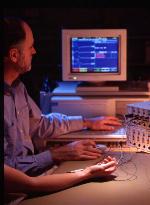
 |
Automatic Decomposition of the Electromyogram |
Investigator: Kevin C. McGill, PhD
Project Staff: Zoia C. Lateva, PhD and Charles G. Burgar, MD
Objective: Assessment of neuromuscular function in patients with suspected neuromuscular disorders is routinely based on analysis of electrical signals recorded from nerves and muscles. The objectives of this project are to develop quantitative ways of analyzing electromyographic (EMG) signals and to gain a better understanding of the way in which these signals are determined by the anatomical and physiological properties of the muscle. We expect that this work will lead to more objective and more sensitive methods for diagnosing patients with suspected neuromuscular disorders, for planning aspects of their curative and rehabilitative therapy, and for evaluating their response to treatment.
Work Accomplished: Results from an investigation of surface-recorded motor-unit action potentials (MUAPs) and compound muscle action potential (CMAPs) show that CMAP and MUAP shapes are determined by anatomical as well as physiological factors. Surface-recorded CMAPs and MUAPs can be divided into four parts corresponding to four stages of electrical activity in the muscle: (1) The rising edge corresponds to the initiation of the action potential at the endplate. (2) The spike corresponds to the propagation of the action potential along the fibers. (3) The terminal wave corresponds to the termination of the action potential at the muscle/tendon junction. (4) The slow afterwave corresponds to the slow repolarization stage of the muscle-fiber membrane. Based on these findings, we have developed new, non-invasive techniques for measuring the dispersion of motor-nerve conduction velocities and the muscle velocity recovery function.
Research Plan: Our current focus is to study the way in which the shapes of needle-recorded motor-unit action potentials (MUAPs) are determined by the architectural properties of the motor unit and the repolarization characteristics of the muscle-fiber membrane. Several muscles with different fiber lengths, pinnation angles, and endplate organizations will be studied in normal subjects and patients with myopathic and neurogenic disorders. MUAPs will be recorded from individual motor units at different points within their territories and at different points along their axes. This will be accomplished by recording EMG signals simultaneously with multiple needle electrodes during moderate voluntary contractions, and then decomposing the EMG signals into their constituent MUAPs. The MUAP waveforms recorded at the different locations will be analyzed using biophysical models to estimate motor-unit architectural properties, including muscle fiber length, endplate locations, pinnation angle, and motor-unit size, and muscle-fiber membrane properties, including conduction velocity and timecourse of slow repolarization.
These experiments represent an important improvement on previous investigations of the MUAP. First, they take into account the termination of the action potential at the muscle/tendon junction and the slow repolarization of the muscle-fiber membrane, which are now know to make important contributions to MUAP shape. Second, we have developed a computer-aided decomposition method that lets us analyze eight different motor units, on average, per recording. This will enable us to examine the architectural properties of motor units not just in isolation, but in relation to neighboring motor units.
Findings: We studied the determinants of motor-unit action potentials (MUAPs) and compound muscle action potential (CMAPs). Our results show that CMAP and MUAP shapes are determined by anatomical as well as physiological factors. Surface-recorded CMAPs and MUAPs can be divided into four parts corresponding to four stages of electrical activity in the muscle: (1) The rising edge corresponds to the initiation of the action potential at the endplate. (2) The spike corresponds to the propagation of the action potential along the fibers. (3) The terminal wave corresponds to the termination of the action potential at the muscle/tendon junction. (4) The slow afterwave corresponds to the slow repolarization stage of the muscle-fiber membrane.
| Related Work: Diagnosing Neuromuscular Disorders |
 |
Funding Source: VA RR&D Merit Review
Years: 1995-1998